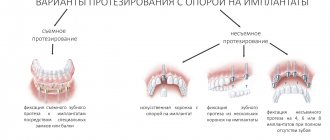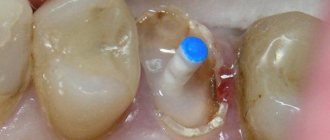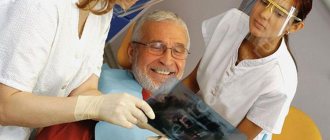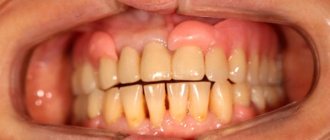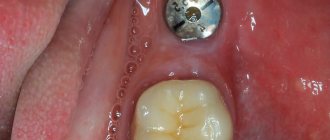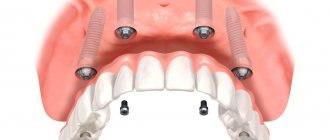Today, dentists have a lot of options for prosthetics - restoring a damaged or missing tooth. One of the most effective solutions is metal ceramics - it is reliable and aesthetic. With its help, you can restore one or more teeth, and the structure is supported by implants or the patient’s own teeth.
Metal-ceramics are orthopedic structures - crowns and bridges, which are made by spraying or casting ceramics onto a metal base or frame. This method of prosthetics is in great demand, since the material used to restore the shape and function of the tooth does not cause allergic reactions. Metal-ceramic prosthetics are more often performed for the masticatory region, since in this case the strength of the structure is a priority, but this does not at all deprive artificial teeth of their aesthetics. Such designs closely replicate the structure and color of natural teeth.
What is dental prosthetics?
This is a set of therapeutic measures aimed at restoring the appearance, aesthetics of a lost tooth or the entire dentition, chewing function and speech. Dental prosthetics is also necessary to preserve the remaining teeth in the dentition, to prevent deformation of the lower, upper jaws and temporomandibular joints. Correctly installed modern structures can completely replace lost teeth. You just need to choose a dental clinic with a good reputation.
What are the dangers of missing teeth?
If there is an incomplete dentition in the oral cavity, then this fact can lead to various complications and diseases. Teeth help a person to eat in a natural way, which was laid down by nature itself. With incomplete dentition, problems of various types may arise, namely:
- An abnormal bite may develop. If one or more teeth are missing in the dentition, the jaw can adapt to new conditions, as a result of which healthy ones will shift. This process occurs so that balance is maintained and ineffective areas of the mouth are not used.
- Gastrointestinal diseases may develop. Improper chewing of foods due to incomplete dentition can increase the load on the stomach, which may result in pain.
- Psychological and physical discomfort that appears with incomplete dentition. A person with such a condition of the oral cavity is embarrassed to smile, and accordingly can withdraw into himself. Especially when the front incisors or canines are missing.
To avoid problems of this nature, it is recommended to contact a dental clinic. Dental prosthetics in case of missing teeth will help to cope with many problems.
Important: when choosing a dental clinic to perform dentures, it is worth considering the availability of specialized equipment on which the dentures will be made. Also, in order for the prosthesis to be comfortable, suitable in all respects and convenient, it is necessary to take into account the correctness of the initial examination, diagnostics, taking measurements and further manufacturing of the dental part, which can only be done in a clinic that has an appropriate approach.
Indications for prosthetics
Dentures are installed:
- when one or more teeth are lost in one row - if this is not done in time, nearby teeth begin to gradually shift, taking the place of the removed one; this leads to an imbalance in the dental system;
- with the loss of several teeth in opposite rows, there is a high risk of dysfunction of the temporomandibular joint, chewing and speech;
- with complete loss of teeth (edentia);
- after surgery for partial removal of jaw bones due to tumors or severe purulent-inflammatory processes.
Pros and cons of dental prosthetics
Various methods of installing dentures have both advantages and disadvantages. But there are more benefits, since orthopedic treatment significantly improves a person’s quality of life.
Advantages
The advantages of prosthetics are obvious. This:
- improvement of appearance; in case of problems with the front teeth, problems of eliminating stress and social adaptation are also solved;
- preservation of jaw bone tissue is a very important function, since when a tooth is absent for a long time in a cell, the bone is resorbed and the dentition shifts, disrupting the function of the dentofacial system;
- correct distribution of the load when chewing;
- elimination of speech defects - dentures in the complete absence of teeth contribute to its restoration;
- prevention of dysfunction of the temporomandibular joint.
Flaws
The disadvantages of installing dentures for teeth are not so noticeable, but they are:
- discomfort in the first days, sometimes the process of getting used to the structure is delayed due to the individual characteristics of the patient’s soft tissues (abrasions and irritation of the gums);
- in some cases, the patient is contraindicated for prosthetics using the method he has chosen and has to choose another method, which does not always suit him for various reasons;
- fixed bridge products require pre-treatment of the supporting teeth and can overload them, leading to loosening;
- improperly installed removable models can place uneven pressure on the jaw, contributing to partial atrophy of its bone;
- a crown or inlay can make root canal treatment difficult for secondary caries.
A good dentist takes into account all the pros and cons, smoothing out the latter and avoiding complications.
Preliminary consultation
The first stage, mandatory in any case, is a preliminary consultation, during which the patient receives answers to the questions he has accumulated related to oral health. The duration of a visit to the dentist is no more than 30-40 minutes, during which the following manipulations are performed:
- Visual examination of the oral cavity and dentition, necessary to identify problem areas, old fillings and dentures, assess the sensitivity of damaged units, the functionality of the muscles and ligaments of the TMJ, as well as form a general idea of the work ahead;
- Oral interview, analysis of medical history and determination of methodology. The dentist informs the patient about all the nuances associated with the recommended treatment method, and also clarifies the presence of possible contraindications that could affect the choice of material or prosthetic protocol;
- Formation of a treatment plan reflecting a step-by-step list of planned actions, the need for which is determined by the specifics of a particular clinical picture. At this stage, the cost and duration of treatment are also agreed upon.
In situations where the pathology is complex, it is also possible to involve doctors in related fields, whose consultation is necessary for high-quality diagnosis.
Types of dentures
There are different types of dentures. The dentist decides which dental prosthetics is suitable for a given patient, coordinating this issue with his aesthetic needs and financial capabilities.
Removable dentures
The patient removes, puts on, and cleans dentures of this type independently. Removable dentures are divided into plate and clasp.
Plate prosthesis
Plate dentures for teeth
Plate dentures are classic removable dentures, consisting of a plastic plate that follows the relief of the gums and palate to which it is applied (base) and artificial crowns. Plate (plate) models are divided into complete dentures (for complete edentia) and partial dentures (for incomplete edentia). Modern designs of lamellar removable dentures made from soft hypoallergenic materials are very popular.
Installation of lamellar removable dentures: if the patient has teeth left, the structure is fixed to them using special clasps; with complete edentia, it is fixed by clenching the jaws - thus removing air and the structure sticks to the mucous membrane. Special fixing adhesives and creams are also used.
The advantages of complete removable dentures: low cost, easy care, ease of manufacture, and the possibility of repair. Disadvantages: relative fragility and the need for replacement every three years, tissue atrophy due to uneven load, inflammatory processes of the periodontal tissues, insufficient fixation in the oral cavity. Contraindications to complete removable dentures: mental illness, allergic reaction to plastic, significant malocclusion.
Clasp denture
Bugel prosthesis for teeth
Bugel dentures are more modern partial removable dentures. They consist of support clasps (they fix the prosthesis on the remaining natural crowns and can have a different design), a connecting arch (clasp) and a saddle, located in places where teeth are missing and holding the structure in the desired position. Installation is possible only if the patient still has his own dental crowns on both sides of the jaw, that is, these are dentures with partial absence of teeth.
The advantages of clasp removable dentures: they stay well in the oral cavity and take up minimal space, fully perform the chewing function (the chewing load is distributed evenly), do not have a negative effect on speech, and remain in working condition for a long time; repairs are possible during operation. The disadvantages of clasp removable dentures include a more complex manufacturing process, which results in a higher cost, since these are the best removable dentures. Clasp dentures are not installed in the absence of teeth, due to the impossibility of fixing the structure on both sides of the jaw.
Conditionally removable dentures
Conditionally removable dentures all-on-4 and all-on-6
This type of prosthetics is performed on implants - artificial titanium roots. First, implantation is carried out, and then the plate prosthesis is installed and tightly attached to the implant. This design is called conditionally removable because the dentist can remove it, clean it and reinstall it.
Installation of a conditionally removable dental prosthesis is carried out using the all-on-4 and all-on-6 methods (all on four or all on six implants). Implantation and prosthetics are carried out simultaneously or at intervals of 2–3 days. The advantages of this technique are its reasonable price, strong fixation in the oral cavity and complete restoration of the patient’s chewing and speech functions. There are practically no downsides; a prosthesis can be installed even with a long absence of teeth and atrophy of the jaw bone tissue. Many people consider these dentures to be the best.
Read more about dental implantation in this article.
Fixed dentures for teeth
This is the most popular type of dentures for teeth with incomplete edentia. The structure is installed in place of the missing tooth (or part of it) and is firmly fixed. There are several subtypes of fixed models. Each of them has its own indications and contraindications.
Fixed dentures
Bridges are a structure consisting of two crowns on supporting teeth and artificial crowns firmly connected to them. A bridge usually contains 1-3 artificial crowns, rarely more - this compromises the strength and reliability of the structure. A bridge is the most common and popular type of permanent structure. The indication for installation is the absence of one or more teeth in a row. Contraindications: absence of 4 or more teeth in a row. Pros: quite durable, reliable and not very expensive design. Disadvantages: installing a bridge requires grinding down healthy supporting crowns; at the site where the artificial crown is installed, the jaw does not receive load, so the tissue may atrophy.
Veneers are thin, durable ceramic or composite plates used to hide defects in the front teeth. Veneers are made of ceramics or composites and are glued to the front surface of the crown, hiding defects such as chips, slight curvature, changes in color or shape of the tooth. The advantages of veneers are: high strength, aesthetic appearance (beauty of a smile), biocompatibility with tissues. Cons: high cost, need to grind down a healthy crown.
Inlays are orthopedic structures made from individual patient impressions in a dental laboratory. Inlays are installed mainly on chewing teeth with significant destruction of the crown. They replace a filling, but are more reliable and aesthetically pleasing. They are made from different materials; ceramic and metal inlays are widespread. Nowadays, tabs are used more and more often. Pros: durability, no depressurization, aesthetic appearance, full functionality. Cons: More expensive than fillings.
Crowns are artificial caps that are installed on a destroyed natural crown, repeating its shape. Before installing a crown, treatment, filling, and grinding for the crown are carried out. If the crown is completely destroyed, a stump tab is first installed in the root canals - it serves as a support for subsequent prosthetics using an artificial crown. These dental prostheses are made from different materials - metal, ceramics, composites, zirconium dioxide, etc. The advantage of these designs is the preservation of chewing and speech function, preservation of the natural load on the jaw bone tissue, and aesthetic appearance. Cons - artificial crowns made of plastic often change their color under the influence of food coloring.
Dentures for teeth on implants - artificial crowns are attached to implants - titanium roots. The method is used when the natural crown is completely destroyed and removed along with the root. There are methods of immediate and delayed prosthetics on implants. In one-stage procedure, a titanium root is inserted immediately after tooth extraction, after which prosthetics are performed. The delayed technique requires complete implantation of the implant and only after this (several months) prosthetics are performed. Pros: all functions of the dentition are almost completely preserved. Cons: the procedure is quite expensive.
Stage 7: prosthetics
After 1-2 weeks from the installation of the abutment, impressions of the teeth and jaws can be made. Crowns can be made from absolutely any material, but ceramic products are more suitable for front teeth. Implant roots in the area of chewing teeth are complemented by metal-ceramic or zirconium crowns.
The price of prosthetics varies depending on its type, since both crowns and removable, as well as conditionally removable dentures are placed on implants. In addition, the cost is affected by the material they are made of.
On a note! Zirconium is the most expensive, but also the most reliable material, which has high strength and excellent aesthetic qualities.
Types of prostheses by material
Dentures are made from a variety of dental materials. All of them have advantages and disadvantages, indications and contraindications for use. The orthopedic dentist must take all this into account. Basic requirements for materials: strength, biocompatibility with human tissues, lack of toxicity, allergenicity, effects on taste and olfactory receptors. The following types of materials are distinguished:
- metal – used for the manufacture of crowns, inlays, bridges; These are mainly precious metals, their alloys and hypoallergenic types of steel; titanium, as well as a nickel-cobalt alloy, are suitable for the manufacture of clasp dentures;
- zirconium dioxide is the most durable material; it looks beautiful in appearance, so it is used to make crowns of any teeth; The disadvantages include its ability to erase the surface of natural antagonist teeth;
- ceramics (dental porcelain) is a very fragile material in its pure form, so today it is rarely used in its pure form for making crowns and only for the front teeth; Dental materials made from glass ceramics are in great demand; famous world brands: Empress Esthetic (Ivoclar Vivadent, Liechtenstein) - glass ceramics based on lithium disilicate - a hard but quite elastic material, dental prostheses made from which can last a lifetime;
- E-max (Ivoclar Vivadent, Liechtenstein) - glass ceramics based on lithium disilicate; used for the production of crowns, inlays, veneers, bridges of the highest quality - hard, durable and very aesthetic, completely consistent with natural teeth; the crowns are very thin, so the teeth underneath do not require significant grinding;
- Ceramage (SHOFU Dental, Germany) - microceramics based on zirconium silicate;
- acrylic - the advantages of this material include lightness, plasticity, and affordable price; cons – removable acrylic dentures can cause allergies and often break;
You should trust your dentist in choosing the material. He will select the material that is most suitable in terms of properties, quality and price for a particular patient.
How are dentures made?
The process requires highly qualified orthopedists and dental technicians, an individual approach and precision of execution. All work consists of several stages.
Stage one - taking impressions
An impression is an impression of the oral cavity using dental elastic material that can retain its shape. For prosthetic restoration of 1 – 2 crowns or a bridge, anatomical casts are used, reflecting the condition of only part of the dentition. If prosthetics is necessary with complete edentia, a functional cast is required that reflects the relief of not only the dentition, but also the adjacent tissues (gums, palate).
Taking an impression of the jaw
Depending on the type of structure and the characteristics of the patient’s tissues, different materials are used to obtain impressions: gypsum (almost not used today due to uneven hardening and fragility), silicone masses (the most popular type), dental wax masses (give clear imprints, but do not keep their shape for a long time), etc.
The impression taking procedure takes about half an hour and includes:
- drying the oral cavity - some types of impression materials lose their properties from moisture; it is removed with napkins or an air stream;
- selecting the material for the impression and placing it in a special standard tray for impressions; if there are significant defects in the dental system, individual spoons are made;
- the spoon is applied to the dentition, the patient clenches his jaws and waits 2 - 3 minutes until the impression mass hardens;
- The impression is washed under running water, placed in a special solution and sent to a dental laboratory.
An impression can also be taken using a more modern method using a 3D scanner. It can be immediately transmitted via the Internet to the dental laboratory.
Stage two - creating a plaster or computer 3D working model
Based on the impression obtained, a working model is made in a dental laboratory - an exact copy of the prosthetic area. A working model is necessary for maximum fit of the future prosthesis. It can be made in a traditional way - the model is cast from a cast from various materials (gypsum, epoxy resin, etc.) or digitally, based on a 3D image. The digital method is more accurate, therefore it saves the orthopedist’s time and reduces the frequency of patient visits.
Stage three - making a prosthesis
Based on the working model, the final version of the denture is manufactured in a dental laboratory at a dental clinic or in independent production. It can be made in the traditional way by hand or using modern CAD/CAM technologies. These technologies make it possible to create individual parts of a structure from different materials on robotic machines. If necessary, the laboratory repairs the product.
Terms of removable prosthetics
The manufacture of removable structures also requires some time. First, the dentist takes impressions of the jaws and sends them to the laboratory. Then it takes two to three days to make the models, after which the first fitting is carried out. About three to five more working days are required to produce the future prosthesis. After trying it on and fitting it takes about a week. The patient then tries on the design again and, if necessary, adjustments are made again. Thus, the production of removable orthopedic structures takes an average of three weeks.
Installation of dentures
Installation of the finished model is carried out according to certain rules (protocols). In this case, at the first consultation, the orthopedist develops an examination and preliminary treatment plan, and then works closely with the dental technician, adjusting the working or finished model to the required parameters and eliminating discomfort in the patient’s oral cavity.
Installation of prostheses is carried out according to a specific protocol
Oral preparation
This stage includes a thorough examination of the patient and treatment of all identified pathologies. Professional teeth cleaning and treatment of caries of teeth that serve as a support for the prosthesis are also carried out. Sometimes, in the process of preparation, the patient receives surgical assistance: removal of a tooth, a cyst at the root apex, hypertrophied (excessively overgrown) soft tissue, etc.
If the patient requires orthodontic care before prosthetics, the teeth are straightened and braces are installed for this purpose. Orthopedic preparation is necessary if, after a long absence of one or more teeth, the interdental spaces are reduced. Depending on the existing problems, this stage can take from one day to several weeks and even months.
Preparing the support for the prosthesis
To install dentures (except for plate products with complete edentia), it is necessary to prepare a support. It can be of two types:
- the patient’s own teeth – they are ground down so that they can be fitted with a crown or a retaining lock; will take no more than 30 minutes, no anesthesia is required;
- implants (titanium roots) – implantation can be carried out simultaneously (immediately after tooth extraction) or delayed, after some time; performed under local or general anesthesia and will take about an hour; The doctor decides after what time to perform prosthetics.
How are dentures attached?
After taking an impression, a working model is made in the dental laboratory. It is tried on in the orthopedist's office. If there are any discrepancies or the patient feels discomfort, the orthopedist notes this and sends the model to the dental laboratory for revision. He can also correct something in the model himself. Fittings are carried out until the working model fully matches the area of the dentition to be replaced. Usually two fittings are enough at intervals of 2 - 3 days. Each fitting will take about half an hour.
A week later, the finished model is installed in the orthopedist’s office. If necessary, the doctor slightly adjusts the finished product. The total manufacturing time of the structure depends on what type of dental prosthetics was performed. So, it will take about three weeks to make a removable clasp denture.
Timing of prosthetics on implants
If the patient chose implantation to restore teeth, the final stage may occur in six months or longer. This is due to the fact that before the installation of prostheses you have to undergo several procedures and operations. In particular, when using the classical technique, before obtaining the final result it is necessary:
- insert artificial roots into the jaw - implants;
- wait until the rods are overgrown with bone tissue and stabilized;
- undergo the second surgical stage of implantation to install the former;
- after two weeks, install the abutment and take impressions to make the crown;
- do a fitting and, if necessary, correction of the prosthesis.
After all these manipulations, the time comes to install a permanent artificial tooth. The general time frame for prosthetics, including implantation, in this case can range from four to seven months.
Possible complications after dental prosthetics
If you choose the right clinic with qualified specialists, the risk of complications is minimal. But complications are sometimes associated not with medical errors, but with the characteristics of the dental tissues and the general health of the patient. Therefore, it is impossible to completely exclude them. Main causes of complications:
- incorrect choice of prosthesis design and material for its manufacture;
- untreated infectious and inflammatory processes in the oral cavity;
- violation of the technology of individual stages of prosthetics;
- patient's failure to comply with oral hygiene;
- the patient has common diseases that reduce immunity - diabetes, etc.
Types of complications:
- Infectious and inflammatory processes of the gums and oral mucosa (gingivitis, periodontitis, stomatitis) due to rubbing of soft tissues by the prosthesis or compression of blood vessels and nerves; if the problem cannot be resolved with antibacterial therapy, the prosthesis is removed, the pathology is treated and prosthetics are re-placed.
- Secondary caries – develops in supporting teeth under crowns; Thorough daily oral hygiene and professional teeth cleaning twice a year will help.
- Allergy to dental material – severe swelling of the mucous membrane, headache; requires immediate removal of the prosthesis, treatment and subsequent re-prosthetics using a product made of a different material.
- Destruction of the prosthesis - chips, cracks, etc. - can occur when eating hard food, hitting the jaw area, etc.; a small chip can be eliminated using modern filling materials; but if the product is completely destroyed, it must be replaced.
- Crowns that are too high or low - the chewing process and the load on the jaw tissue are disrupted; replacement of the prosthesis is necessary.
- A denture has fallen out - you need to save the fallen product and urgently contact a dentist.
Moderate pain after prosthetics is normal. They are associated with the adaptation of tissues to new designs and pass over time. But if the pain increases and is accompanied by swelling and redness of the tissues, you need to consult a doctor.
Signs of denture rejection
Sometimes (very rarely) rejection of the implant root occurs - the titanium root (the basis of the prosthesis) for some reason does not take root in the patient’s tissues. This can happen either one or two days after implantation, or much later. More often, implants do not take root in smokers and in patients who do not maintain oral hygiene. Signs:
- the gums bleed for a long time (more than three days);
- body temperature rises, it may not be high, but it can rise to significant numbers;
- moderate pain, which normally appears after implantation, sharply intensifies and becomes acute;
- the gum and adjacent cheek swell;
- after some time, pus appears from the gums;
- there will be a feeling of weakness, weakness, headache;
- the titanium root and the prosthesis installed on it can become mobile and even fall out of the gums.
If such symptoms appear, you should immediately contact your dentist.
High-quality turnkey dental prosthetics from the Presidential dental chain
Not every dentistry can successfully carry out turnkey dental prosthetics. Due to an unprofessional procedure, the patient may experience complications. It is important to correctly differentiate complications from possible short-term postoperative sensations.
If, as a result, during the first three days the patient experiences slight bleeding in the area of the incision of the gum tissue, slight swelling, or slight periodic pain that is suppressed by painkillers, then there is no need to worry. You should sound the alarm in cases where severe pain occurs that does not stop even after taking painkillers, and bleeding that does not stop. In this case, the dentist made mistakes during the procedure.
Important: if the installed denture rubs the gums, causing discomfort that lasts for a long time, then you should definitely contact your dentist to correct the defect in order to avoid further complications.
In our dental network "President" such issues as incorrect dental prosthetics are completely excluded. There is indisputable evidence of this:
- The team consists of exclusively professional orthodontists and specialists with higher specialized education. The employees of our dental network "President" in Moscow constantly undergo advanced training in modern methods of treatment and dental prosthetics, and the study of modern computer equipment. They have incomparable experience in the dental field, have certain skills, knowledge and abilities.
- Dental clinics use high-precision modern equipment and instruments.
- We use only high-quality materials in our work. We work only with trusted suppliers of dental products.
- We have a large customer base.
- We pay special attention to each patient, try to approach each patient individually, solving even the most complex problems inexpensively.
Rules for caring for dentures
When installing any type of dentures, you must follow the oral care rules recommended by your dentist. They depend on what kind of dental prosthetics was performed. If removable dentures are installed:
- immediately after installing the structure, do not remove it for several days in a row at night, while eating, talking (even if it interferes), until the tissues get used to the pressure exerted on them;
- when the pain and discomfort from wearing the prosthesis go away, it can be removed at night; but modern construction materials make it possible to wear them constantly;
- Every morning and evening after removing the denture, it is washed with cold running water and cleaned with a soft toothbrush and toothpaste without abrasive;
- at night, the prosthesis can be placed in a special protective container or in a container with a disinfectant solution intended for long-term storage; it can be bought at the pharmacy in finished form or in the form of tablets that dissolve in water; clasp dentures with metal parts must be stored in a solution with anti-corrosion properties;
- after each meal, it is advisable to remove the denture and rinse it with water, as well as rinse your mouth;
- Once every six months, the denture can be taken to the dentist for professional cleaning;
- if severe pain, erosion, or inflammatory processes appear in the oral cavity, you should contact a dentist; In this case, it is necessary to install a removable dental prosthesis three hours before the appointment so that the doctor can see exactly what is happening.
Maintenance of the fixed structure:
- In the morning and evening, you need to brush your teeth with toothpaste without abrasive;
- after eating, rinse your mouth with boiled water or mouthwash, and also rinse the interdental spaces with an irrigator;
- It is better not to use dental floss - as a result of their use, the product may be damaged;
- Carry out professional cleaning every six months.
Orthopedic stage
In this part of the preparatory process, the doctor examines teeth that are susceptible to secondary deformation as a result of the removal of ontogonists or adjacent teeth. In such cases, specially made trays are used (plates are also popular), which make it possible to move teeth that have protruded. To produce mouth guards, samples of the masticatory muscles are taken. This procedure is used to avoid destruction of the prosthesis immediately after installation.
The stages of dental prosthetics may seem unnecessarily drawn out and complicated, but this process is a priority, being more important than the procedure itself, which is what all the fuss is about. Preparing for dental prosthetics will ensure high-quality treatment, which will ultimately allow you to complete mandatory trips to the dentist, leaving room only for prevention.
Fixation of dentures
Fixing agents are used only if removable dentures are installed, since they allow the structure to stay more firmly in the oral cavity and also have a shock-absorbing effect, reducing irritation of soft tissues. Most of these products also have antibacterial properties.
Cream for fixing dentures
These include:
- fixing creams, gels, adhesives - they are applied to the surface of the prosthesis adjacent to the patient’s tissues, strictly according to the instructions (some are applied only to dried mucosa); Please note that creams and gels have different durations of action: the widely advertised Corega cream lasts 3–4 hours, Rocs cream lasts up to 12 hours (optimal duration), and Lacalut - 24 hours; You should also keep in mind that some fixatives contain zinc, which has a good anti-inflammatory effect; but with prolonged use of such drugs, an overdose of zinc occurs, which is harmful to the body, therefore zinc-containing fixatives can only be used in courses of 3 to 4 weeks with long breaks;
- powdered products - sprayed onto the surface of the removable dental prosthesis, then the product is put on in the usual way and lightly pressed against the gums and palate;
- strips of fabric - designed to tightly fix a removable denture in the absence of teeth and make it more comfortable to wear.
An orthopedic dentist will help you choose the right fixation agent.
Materials for the manufacture of prostheses
The materials used in dental clinics for the manufacture of dentures must meet certain requirements for them. These requirements include the following:
- the material must be biologically compatible with the gingival tissues in the oral cavity;
- the material must be resistant to saliva and food;
- it should not cause allergic reactions;
- should not change taste sensations;
- should not emit a smell;
- the characteristics of strength, elasticity, resilience and abrasion should be close to those of the tissue being replaced;
- the material should be more similar in color and appearance to natural teeth.
The following materials are used:
- Metal. For many years, dentures were made from gold. Nowadays you can also encounter people with gold prosthetics. In modern times, other metal alloys are increasingly used. A metal frame is made from a metal alloy, which is then coated with ceramics. This is how metal dentures are made. This type of dental parts is most popular today in dental clinics.
- Ceramics. The material is distinguished by the fact that it is fully compatible with soft gum tissues, there are no allergic reactions from it, and it can be used to create natural gum contours. Ceramic dentures can be painted in a color that best conveys a healthy color.
- Plastic. This material is most often used in the production of artificial teeth and bases for removable dentures. Dental laboratories use acrylic resin-based plastics to create acrylic dentures. Polyurethane and nylon dentures are also manufactured using non-acrylic polymer compounds.
Contraindications for prosthetics
Currently, there are many methods of prosthetics and the dental materials used, so in most cases the patient can choose the type of dental prosthetics that is most suitable for him. The dentist decides which dental prosthetics is suitable for the patient. There are a minimum of contraindications for the installation of fixed and removable dentures; all of them are divided into absolute and relative.
Absolute
Contraindications to any type of prosthetics are severe mental illness with social adaptation disorder. The rest relate mainly to prosthetics on implants. These are diabetes mellitus, cancer, systemic connective tissue diseases, and significantly reduced blood clotting.
Relative
These are currently existing contraindications. They can be general and local. Common ones include acute infectious and inflammatory processes and exacerbation of any chronic diseases, pregnancy.
Local - gingivitis (inflammation of the gums), stomatitis (inflammation of the oral mucosa), periodontitis and periodontal disease (inflammatory and degenerative-dystrophic diseases of the periodontal tissues) in the acute stage, bruxism (involuntary grinding of teeth), increased tone of the masticatory muscles. After eliminating these contraindications, prosthetics can be performed.

